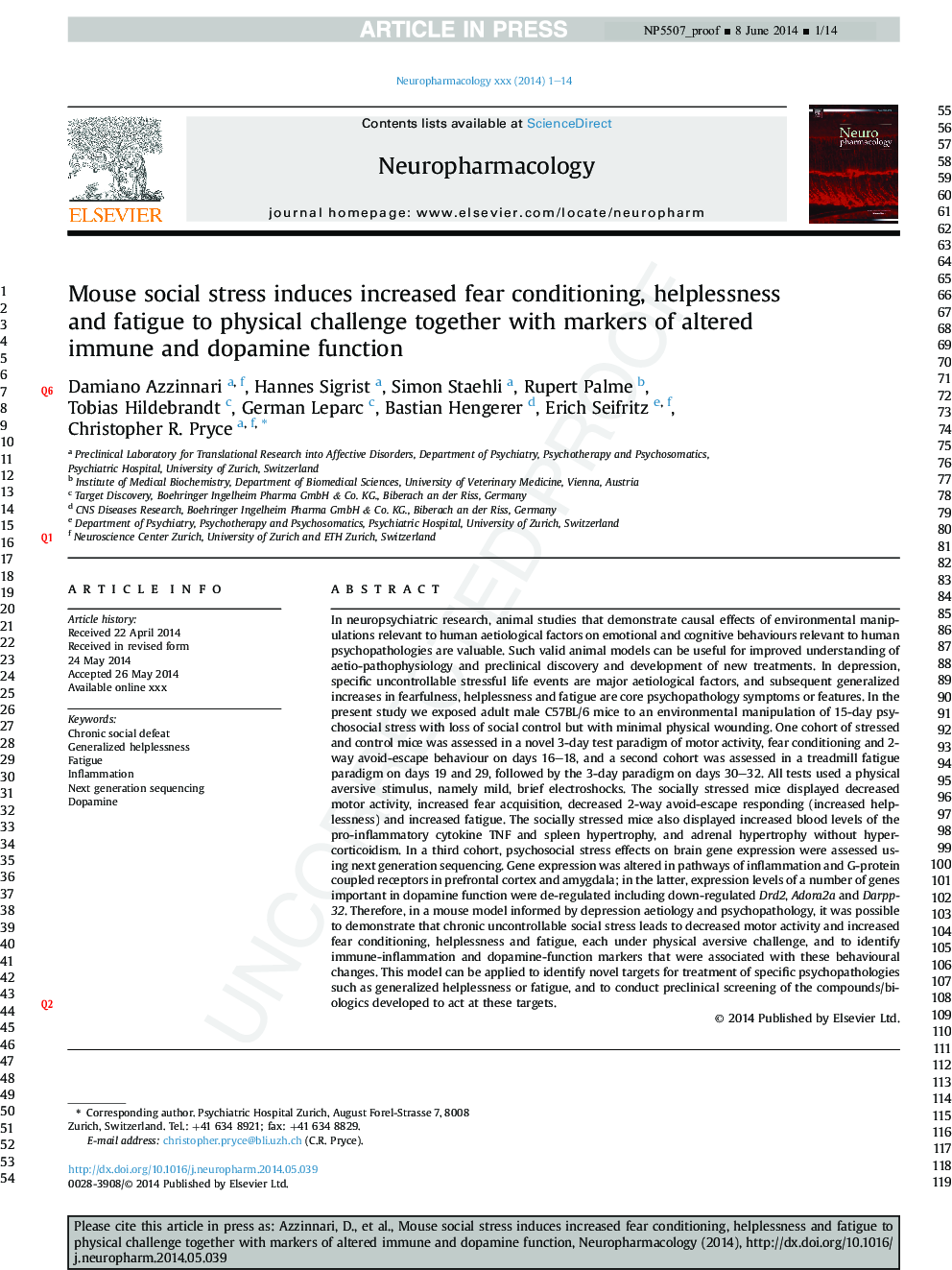| کد مقاله | کد نشریه | سال انتشار | مقاله انگلیسی | نسخه تمام متن |
|---|---|---|---|---|
| 5814434 | 1556629 | 2014 | 14 صفحه PDF | دانلود رایگان |
عنوان انگلیسی مقاله ISI
Mouse social stress induces increased fear conditioning, helplessness and fatigue to physical challenge together with markers of altered immune and dopamine function
ترجمه فارسی عنوان
استرس اجتماعی موش موجب افزایش تهوع، بی نظمی و خستگی به چالش فیزیکی همراه با نشانگرهای عملکرد ایمنی و دوپامین می شود
دانلود مقاله + سفارش ترجمه
دانلود مقاله ISI انگلیسی
رایگان برای ایرانیان
کلمات کلیدی
شکست اجتماعی مزمن، بی نظمی عمومی، خستگی، التهاب توالی نسل بعدی، دوپامین،
موضوعات مرتبط
علوم زیستی و بیوفناوری
علم عصب شناسی
علوم اعصاب رفتاری
چکیده انگلیسی
In neuropsychiatry, animal studies demonstrating causal effects of environmental manipulations relevant to human aetiology on behaviours relevant to human psychopathologies are valuable. Such valid models can improve understanding of aetio-pathophysiology and preclinical discovery and development of new treatments. In depression, specific uncontrollable stressful life events are major aetiological factors, and subsequent generalized increases in fearfulness, helplessness and fatigue are core symptoms or features. Here we exposed adult male C57BL/6 mice to 15-day psychosocial stress with loss of social control but minimal physical wounding. One cohort was assessed in a 3-day test paradigm of motor activity, fear conditioning and 2-way avoid-escape behaviour on days 16-18, and a second cohort was assessed in a treadmill fatigue paradigm on days 19 and 29, followed by the 3-day paradigm on days 30-32. All tests used a physical aversive stimulus, namely mild, brief electroshocks. Socially stressed mice displayed decreased motor activity, increased fear acquisition, decreased 2-way avoid-escape responding (increased helplessness) and increased fatigue. They also displayed increased plasma TNF and spleen hypertrophy, and adrenal hypertrophy without hyper-corticoidism. In a third cohort, psychosocial stress effects on brain gene expression were assessed using next generation sequencing. Gene expression was altered in pathways of inflammation and G-protein coupled receptors in prefrontal cortex and amygdala; in the latter, expression of genes important in dopamine function were de-regulated including down-regulated Drd2, Adora2a and Darpp-32. This model can be applied to identify targets for treating psychopathologies such as helplessness or fatigue, and to screen compounds/biologics developed to act at these targets.
ناشر
Database: Elsevier - ScienceDirect (ساینس دایرکت)
Journal: Neuropharmacology - Volume 85, October 2014, Pages 328-341
Journal: Neuropharmacology - Volume 85, October 2014, Pages 328-341
نویسندگان
Damiano Azzinnari, Hannes Sigrist, Simon Staehli, Rupert Palme, Tobias Hildebrandt, German Leparc, Bastian Hengerer, Erich Seifritz, Christopher R. Pryce,
